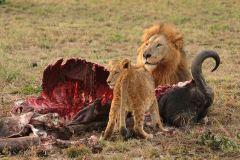
© Luca Galuzzi http://www.galuzzi.it
This interesting review has just come out in Science, and because I was given a heads-up about it, I decided to do a F1000 recommendation. That’s more or less what follows, with some additional thoughts.
Ripple and colleagues can perhaps be excused for stating what might appear to many ‘in the biz’ to be blatantly obvious, but their in-depth review of the status of the world’s carnivores is a comprehensive overview of this essential guild’s worldwide plight. It not only represents an excellent teaching tool, the review elegantly summarises the current status of these essential ecosystem engineers.
The world’s 245 terrestrial carnivores might seem to be ecologically redundant to the informed given their natural rarity, low densities and cryptic behaviour, but nothing could be farther from the truth. Ecologists have only within the last decade or so revealed the essential ecosystem functions of these species (see former posts on CB.com here, here and here). The review focuses on the largest and most well-studied species, but the trends likely apply across most of the order.
We now know that these predators can do so much more than just limit herbivore densities – they can regulate entire ecosystems by manipulating herbivore and mesopredator densities. Indeed, a quick estimate of their trophic effect sizes reveals massive influences where they are present (compared to where they are absent). Further, the order does not represent many redundant functions given the large variation in carnivore size, density, metabolism, sociality and hunting tactics.
The role of carnivores does not end with manipulating the densities of their prey and competitors – they provide a spate of other ecosystem services: from the obvious tourism dollars (watching lions, etc.), to the less well-appreciated increase in carbon sequestration by limiting herbivore abundance and thus enhancing plant growth, and the enhancement of nutrient cycling by supporting detrivore guilds (like scavengers). Large carnivores can even benefit the industry that persecutes them the most – pastoralism – by limiting the density of wild herbivores that compete for vegetation biomass eaten by commercial livestock. They can also potentially soften the impact of climate change on other species by limiting the advance of invasive species, and by promoting regeneration of degraded vegetation as it struggles to cope with new climate extremes.
Unfortunately, these essential ecosystem engineers are extremely prone to persecution and decline/extinction. Of the 31 largest (≥ 15 kg) carnivores (excluding pinnipeds – i.e., seals, sea lions & walruses), 61 % are threatened, 77 % are declining, and the average occupancy of their original ranges is just 47 % (ranging from < 1 to 73 %).
The ages-old notion that predators should be feared and eliminated is waning, but perhaps not quickly enough before the predators themselves disappear. The evidence that they provide positive outcomes for human society is mounting and vindicates these species as vilains. Anyone doubting the essential role of carnivores needs to read this paper.
CJA Bradshaw

